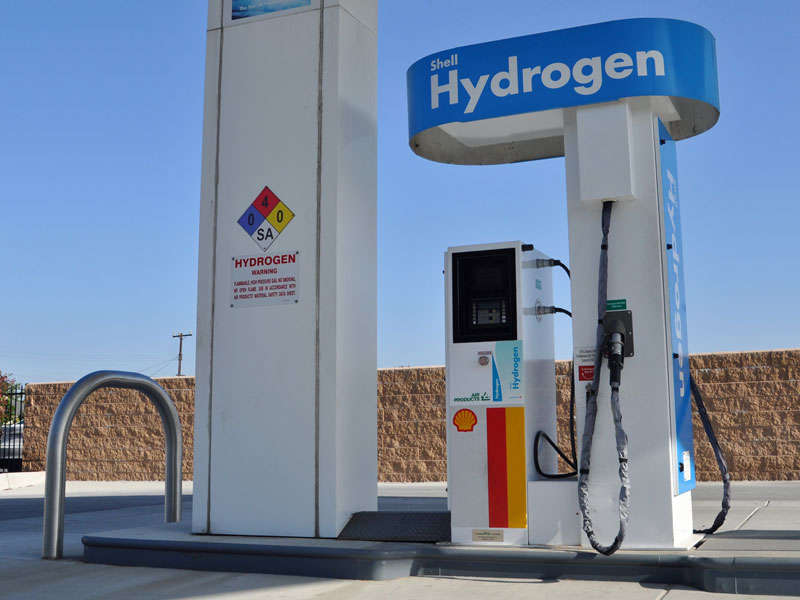Recent Articles
Popular Makes
Body Types
2015 Hyundai Tucson Fuel Cell Review and Quick Spin
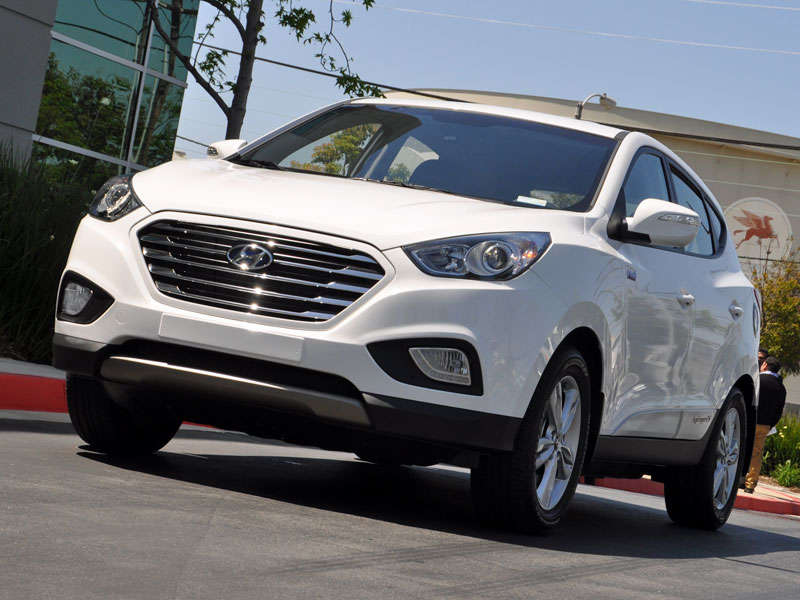
Let me be right up front about something. I spent all of 15 minutes with the 2015 Hyundai Tucson Fuel Cell, just enough time to get a sense of what it’s like to drive, how comfortable it is, and how practical it could be if only there were a dang hydrogen infrastructure to support it. This review is less about the Tucson Fuel Cell in particular and more about fuel cell electric vehicles (FCEVs) in general, using this Hyundai as an illustration to explain the technology, how it works, and what it’s like when you drive the vehicle.
My Tucson Fuel Cell test drive opportunity came in conjunction with a California workshop called Hydrogen Fuel Cell Technology In Your Neighborhood, during which car companies, civic and business leaders, and fire safety officials gathered to talk about existing hydrogen-powered fuel cell vehicles, the future of the technology, the infrastructure required to support it, and what the consequences of inaction will be if the world does not rapidly adopt a zero-emission mentality.
Of course, as I write this, it is snowing upon my fellow Autobytelians as they attend the 2014 New York Auto Show, and Detroit just broke its all-time record for the snowiest winter ever. With this kind of weather, talk of global warming frequently falls on deaf ears. I’m in the Los Angeles suburbs, though, where a few days ago temperatures reached nearly 100 degrees in parts of the region, a portion of the U.S. that saw just a quarter of its already meager annual rainfall this past year.
Let’s forget about local weather patterns, though. After all, the United States accounts for just 2 percent of the world’s surface area. Ask the experts at the National Oceanic and Atmospheric Administration (NOAA) about global trends, and it says that the 10 warmest years for the entire planet have occurred since 1998, and in every year since 1976 Earth’s average annual temperature has been above the long-term average.
Also in the news this week, a United Nations report warning that if human beings don’t do something now to curb the effects of global warming – we’re past being able to stop it – the ultimate costs of inaction will be far more substantial than getting off of our collective butts (right this instant, Mister) and doing anything to stop puffing greenhouse gas emissions into the atmosphere like a drunk uncle blowing smoke rings from a big, fat, stinky cigar.
That brings us full circle to the 2015 Hyundai Tucson Fuel Cell, which will be available in very limited quantities in a handful of Southern California zip codes through only a few Hyundai dealerships. It might not be much, but it is a start.
What is a Fuel Cell Vehicle?
A fuel cell vehicle is an electric vehicle. Instead of drawing power from a huge lithium-ion battery pack that requires frequent recharging, a fuel cell vehicle is equipped with a special tank designed to hold compressed hydrogen gas, a fuel-cell stack that combines the hydrogen with oxygen to create electricity through an electrochemical process, and a compact lithium-ion battery to store energy and assist in powering the vehicle. The fuel-cell stack is a catalyst; combustion is not a part of the process, and a fuel cell vehicle emits nothing but water vapor into the atmosphere.
A fuel cell vehicle creates its own electricity rather than pulling electricity off the grid like a plug-in hybrid or a battery-powered electric car. In the U.S., utility companies burn coal, natural gas, and petroleum to create the majority of the electricity they sell, a process that emits greenhouse gases. While the reformation process used to create the hydrogen that powers a fuel cell vehicle also produces harmful atmospheric pollutants, it is a fraction of the gunk generated by traditional methods.
That’s how the Kool-Aid I drank tasted, anyway.
According to the car companies that participated in the workshop I attended, unlike with a traditional electric vehicle, extreme weather and temperatures do not make a palpable impact on fuel cell vehicle performance. Better yet, a fuel cell vehicle offers greater range than most electric vehicles. When an EV’s battery is depleted, you’ve gotta find an electrical outlet, and wait awhile before you can get back on the road. When a fuel cell vehicle’s hydrogen tank is empty, all you need to do is pull into a hydrogen station, hook up to the pump, and wait about 10 minutes.
The problem, of course, is finding a hydrogen station in the first place.
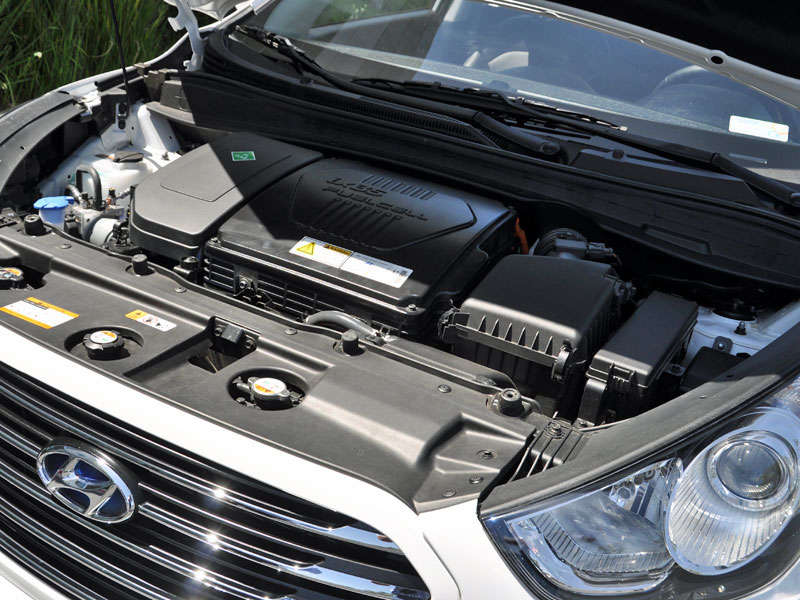
Refueling a Hydrogen Car
If you live in California, there are nine operational hydrogen stations in the state, with 19 more expected to be up and running by the end of 2015. California has earmarked cash for 100 hydrogen stations in strategic locations, but after that private industry is going to need to finance the expansion of a hydrogen infrastructure.
Drive into one of the existing hydrogen stations, and the setup is remarkably similar to a gasoline station. You pull alongside a familiar looking pump, and you open the vehicle’s traditional fuel door. Inside the fuel door, you’ll see a small cap, and when you remove it you’ll see an even smaller connection for the hydrogen pump’s nozzle.
It’s been a few years since I witnessed a hydrogen fueling demonstration that was given by Honda for an FCX Clarity that I was driving for a few days. What I recall is that securing the hydrogen fuel pump’s nozzle to the car isn’t as easy as simply jamming a gasoline pump into a hole and squeezing a handle, but like anything in life, I’m sure it becomes second nature with practice.
Hyundai says it takes about 10 minutes to refuel the 2015 Tucson Fuel Cell. That’s longer than the gasoline version, but far shorter than your typical electric vehicle. Even municipal quick chargers need at least half an hour to juice an EV, and don’t usually provide a complete charge in that amount of time. And if you’re charging at home, using a regular outlet, you’ll need to sleep on it because that takes a loooooong time.
Oh, and don’t forget, a fuel cell vehicle travels longer and farther on a tank of hydrogen than a typical electric vehicle does on a single charge. Hyundai says the Tucson Fuel Cell will travel up to 270 miles on a single tank of hydrogen. That’s more than triple the distance that a Nissan LEAF can cover when starting off with a full battery.

Styling and Design
There are two approaches to designing alternative fuel vehicles. Some automakers style them in such a way that they draw attention to their environmentally friendly wholesomeness, like the 2004 Prius did and like the Honda FCX Clarity does today, while other automakers take stealthy approach that makes it hard to discern any difference from a “normal” car. With the Tucson Fuel Cell, Hyundai takes the latter path.
As can be seen in this poorly lit photo of the Tucson Fuel Cell’s dashboard, complete with greased-up innards following a detail, the interior looks just like that of the regular Tucson, except for a few modifications to instrumentation and displays that are directly related to its unique drivetrain. Comfort levels are identical to the standard Tucson, too. The hydrogen tank is located beneath the vehicle, but rear seat space and cargo volumes are essentially unchanged.
To visually set the Tucson Fuel Cell apart a bit, the front styling is different and it’s got a bunch of badges on it that are intended to let observers know that this is a special vehicle. At a glance, though, most people won’t even notice this SUV, which can be a good thing or a bad thing, depending on whether or not you want extra attention everywhere you go.
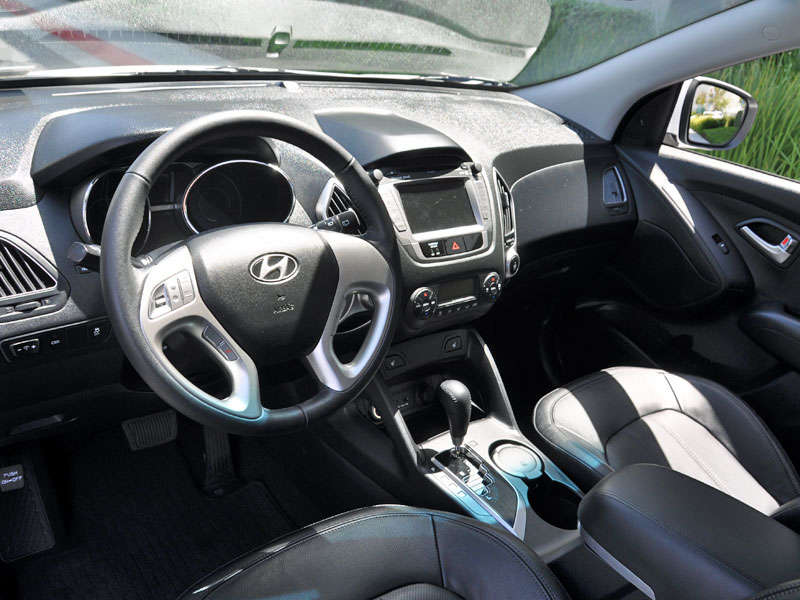
Driving Impressions
If you’ve never driven an electric car before, imagine what driving a bigger, heavier, and more powerful golf cart might be like. Just like a golf cart, an electric car delivers a surge of power the moment you step on the accelerator, and as it attains greater velocity the thrust starts to wane. Of course, a golf cart’s top speed isn’t very high whereas an electric car is designed to travel with the flow of traffic on a freeway, but with most electrics topping out at around 90 mph they’re not exactly blazing down the road.
Hyundai says the Tucson Fuel Cell generates 221 lb.-ft. of torque the moment you step on the accelerator, reaches 60 mph in 12.5 seconds, and can attain a top speed of 100 mph. I had a chance to verify neither of the latter claims. Remember, I took a very short demonstration drive during a related hydrogen infrastructure workshop. I did, however, note that when accelerating from a stop the Tucson Fuel Cell sure feels energetic, in the process making my host rather nervous. Evidently, he’s not accustomed to dealing with automotive journalists.
In any case, in the urban environment where I experienced the Tucson Fuel Cell, it proved speedy when accelerating away from traffic lights and intersections, and when cruising at 45 mph emitted a characteristic electric powertrain whine. The ride quality was firm but not disagreeable, and the Tucson felt heavy, solid, and secure during the drive.
Equipped with regenerative brakes, the pedal feels a little bit odd at first, but with an understanding of how they work and what they do, the driver quickly accepts it and acclimates. Electric steering is standard, naturally, proving light and effortless when parking and taking city corners at low speeds.
I wish I could share more observations, but that would require more seat time than a typical dealership-style test drive can provide. For now, I’ll summarize by saying that aside from learning about what the unique instrumentation does and the information it conveys, and acclimating to how the regenerative brakes feel, the Tucson Fuel Cell requires no change in driving behavior compared to a standard gasoline-powered Tucson.
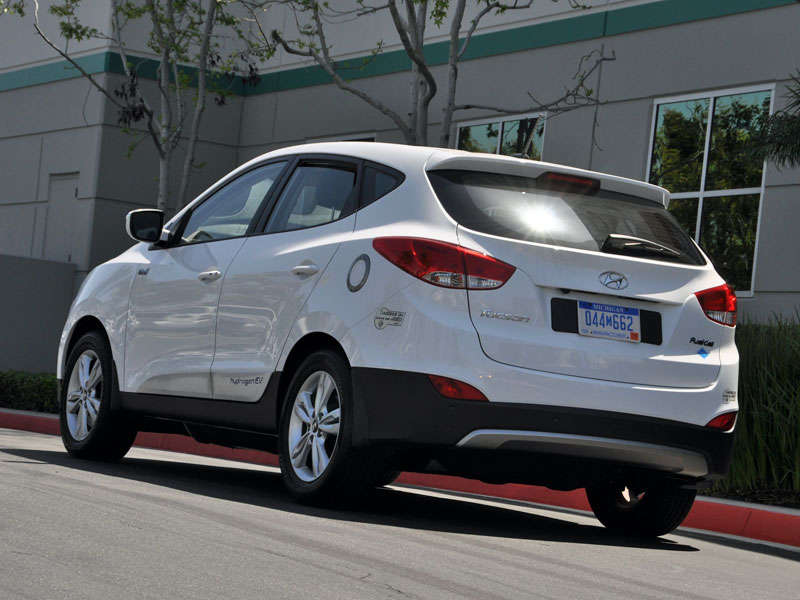
How to Get One
If you live in Los Angeles County or Orange County, you clear the initial hurdle to getting your hands on a 2015 Hyundai Tucson Fuel Cell. Dealers located in Anaheim, Tustin, Carson, and Van Nuys will be the first to lease the SUV, so if that works for you, go ahead and sign up on Hyundai’s consumer website and then wait to hear back.
Next, you need to make sure your budget can handle the lease payment. The lease requires a down payment of $2,999, and then costs $499 per month. You can drive up to 12,000 miles annually, and the lease includes free hydrogen gas, and free At Your Service Valet maintenance. Plus, you get fancy car-pool lane stickers that let you zoom past everyone else during your commute.
So what’s the downside? You’re going to need to figure out how to insure this revolutionary vehicle. The fine print on Hyundai’s website says: “Lessee responsible for insurance.” That’s a different approach than Honda takes with the FCX Clarity, for which it supplies collision insurance as a part of the lease agreement. I asked Hyundai representative Kevin Lee about this, but he declined to comment on the company’s Tucson Fuel Cell insurance strategy, explaining that he couldn’t in advance of the vehicle’s arrival to market.
If you’re not sure whether a Tucson Fuel Cell is right for you, Hyundai plans to make examples of the SUV available for rental through selected Enterprise Rent-A-Car locations in L.A. and Orange counties, giving prospective lessee’s the opportunity to live with one for a few days before signing on the dotted line.
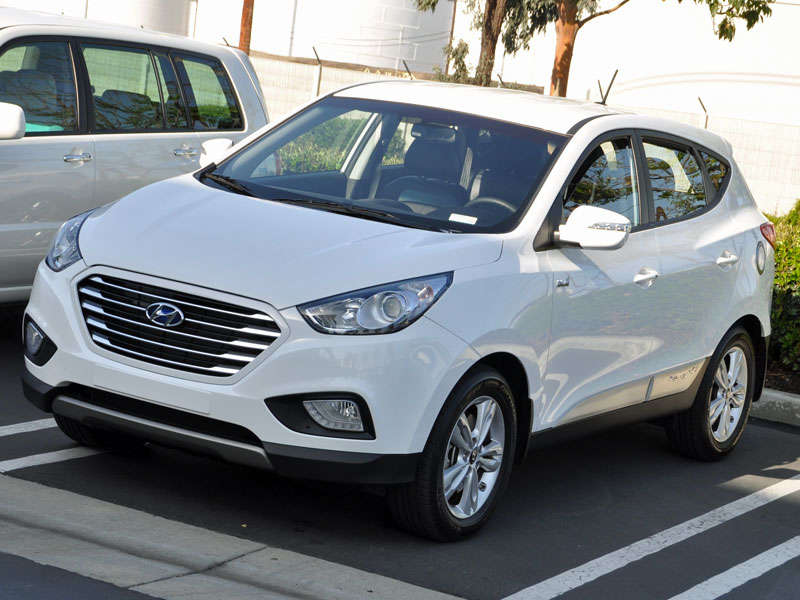
Final Thoughts
Naturally, skeptics balk at the notion of a fuel cell-powered future, whether motivated by fear, greed, power, or an irrational need to argue for the sake of argument. Hydrogen might not be a perfect solution to reducing greenhouse gas emissions, especially since the infrastructure to support it is almost non-existent, but when used to power vehicles and other forms of transportation with electricity, the electrochemical process emits nothing but water vapor into our undeniably warming climate.
As for alternatives to hydrogen, none beat it in terms of “well-to-wheel” greenhouse gas emissions. According to a 2013 study performed by the Advanced Power and Energy Program at the University of California, Irvine, hydrogen fuel cell vehicles reduce emissions by 60 percent compared to a gasoline-powered car that gets 40 mpg, when taking into consideration fuel feedstock, refining, treatment, and production methods before it is used in the vehicle. And if the source of the hydrogen is biogas from wastewater, such as that created by California’s Orange County Sanitation District, the well-to-wheel emissions are nearly immeasurable.
From an end-user perspective, no change in behavior is required to lease, fuel, and drive a fuel cell vehicle aside from learning how a hydrogen pump connects to the vehicle and then waiting up to twice as long for the tank to fill as compared to a conventional gasoline-powered car. As for the 2015 Hyundai Tucson Fuel Cell, of the four fuel cell vehicles I’ve driven over the years, it is the most normal and refined of them all.
The author attended a hydrogen vehicle workshop to drive the Tucson Fuel Cell
2015 Hyundai Tucson Fuel Cell photos by Christian Wardlaw
